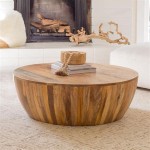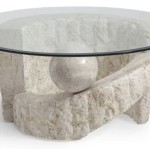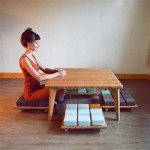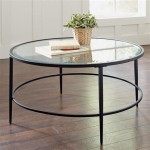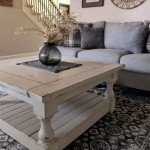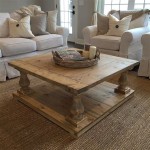Determining the Optimal Height for a Bedside Table
Selecting the appropriate height for a bedside table is a crucial aspect of bedroom design, impacting both functionality and aesthetic harmony. A bedside table, also referred to as a nightstand or night table, serves as a convenient surface for essential items such as lamps, books, eyeglasses, and electronic devices. Choosing the right height ensures these items are readily accessible while maintaining a visually balanced and comfortable bedroom environment. The ideal height is not a fixed number but rather a range determined by several factors, including bed height, personal preferences, and intended use.
The primary function of a bedside table is to provide a readily accessible surface from a lying or seated position in bed. A table that is too low may require excessive reaching, potentially causing discomfort and disrupting sleep. Conversely, a table that is too high can appear visually imposing and create difficulties in accessing items without awkward movements. Therefore, a thoughtful assessment of individual needs and specific bedroom configurations is essential for determining the optimal height.
Key Point 1: Aligning Bedside Table Height with Bed Height
The most crucial factor in determining the appropriate height for a bedside table is the height of the bed itself. The surface of the bedside table should ideally be either level with the top of the mattress or slightly higher. This alignment ensures effortless access to items without requiring undue stretching or bending. To accurately assess the bed's height, measure from the floor to the top surface of the mattress, including any mattress toppers or bedding that add to the overall height.
If the bedside table is significantly lower than the mattress, reaching for items becomes cumbersome and potentially disruptive, especially during the night. A lower table may also necessitate bending over further, straining the back and neck. This can be problematic for individuals with mobility issues or those who experience discomfort when bending or reaching.
Conversely, if the bedside table is considerably higher than the mattress, items may be difficult to see and reach comfortably. A higher table can also create a visually unbalanced aesthetic, making the bedroom feel less cohesive and harmonious. Furthermore, a taller table can potentially pose a safety hazard if items are inadvertently knocked off during the night.
A general guideline is that the bedside table's surface should be within approximately two to six inches of the mattress height. This range provides sufficient leeway to accommodate individual preferences and variations in bed and mattress heights. For example, a bed with a height of 25 inches would ideally be paired with a bedside table ranging from 25 to 31 inches in height.
When choosing a bedside table, it is advisable to consider the potential for future changes in bed height. If there is a possibility of adding a mattress topper or replacing the mattress with a thicker model, selecting a bedside table with adjustable height or a slightly taller option may be a practical approach. This allows for greater flexibility and avoids the need to replace the bedside table to maintain optimal ergonomic positioning.
Key Point 2: Considering Personal Preferences and Intended Use
Beyond aligning with the bed's height, personal preferences and the intended use of the bedside table play a significant role in determining the ideal height. Individuals who frequently read in bed may prefer a slightly taller table to accommodate larger books or reading lamps. Similarly, those who use their bedside table for charging electronic devices may desire a table with ample surface space and a height that facilitates easy access to charging cables.
The specific items intended for storage on the bedside table also influence the preferred height. If the bedside table is primarily used for storing smaller items such as jewelry, medications, or eyeglasses, a slightly lower table may be sufficient. However, if larger items such as laptops, tablets, or decorative objects are to be placed on the table, a taller and more spacious option may be necessary.
Another consideration is the individual's physical characteristics and mobility. Taller individuals may find a slightly taller bedside table more comfortable, as it reduces the need to bend or hunch over when reaching for items. Conversely, individuals with mobility limitations may prefer a table that is easier to reach from a seated or lying position, potentially opting for a slightly lower option.
The overall aesthetic of the bedroom should also be taken into account. A bedside table that is disproportionately tall or short can disrupt the visual balance of the room. Consider the existing furniture and decor when selecting a bedside table, ensuring that its height complements the overall design scheme. A bedside table can serve as a focal point, so using it to balance and harmonize the room can be advantageous.
Personal preferences are, to some extent, subjective, and it may be beneficial to experiment with different heights to determine what feels most comfortable and convenient. One approach is to temporarily use a stack of books or a small box to simulate different bedside table heights and assess the ease of access and overall comfort level. This allows for a more informed decision before committing to a specific bedside table.
Key Point 3: Examining Bed Frame Styles and Matching Strategies
The style of the bed frame significantly impacts the overall bed height and, consequently, the ideal bedside table height. Platform beds, characterized by their low profile and minimalist design, typically require lower bedside tables to maintain visual harmony and ease of access. Conversely, beds with higher frames, such as those with elaborate headboards or footboards, may necessitate taller bedside tables to achieve a balanced aesthetic.
Beds with adjustable bases, which allow for raising or lowering the head and foot of the bed, present a unique challenge when selecting a bedside table. In these cases, it is essential to consider the maximum height adjustment of the bed and choose a bedside table that is tall enough to accommodate the elevated position. This ensures that items remain within easy reach regardless of the bed's configuration.
Another consideration is the presence of drawers or shelves in the bed frame itself. Beds with built-in storage may reduce the need for a large bedside table, as some essential items can be stored directly within the bed frame. In such cases, a smaller and lower bedside table may be sufficient to hold a lamp, a book, and a few other essentials.
Matching the style of the bedside table to the bed frame is also crucial for creating a cohesive and visually appealing bedroom. A bedside table that clashes with the bed frame in terms of material, color, or design can detract from the overall aesthetic. Consider the existing furniture and decor when selecting a bedside table, and strive to create a harmonious and balanced environment.
When choosing a bedside table, it is essential to consider the overall proportions of the bedroom. A small bedroom may benefit from a smaller and lower bedside table to avoid overwhelming the space. Conversely, a larger bedroom can accommodate a taller and more substantial bedside table without feeling cramped. Careful consideration of the room's dimensions helps ensure that the bedside table complements the overall design scheme.
Ultimately, the best height for a bedside table is a personalized decision that takes into account various factors, including bed height, personal preferences, intended use, and bed frame style. By carefully assessing these factors and experimenting with different options, individuals can select a bedside table that provides optimal functionality, comfort, and aesthetic appeal.

Simple Rules For The Right Size Nightstand Every Time

How To Choose The Ideal Nightstand Bedside Table Linenme

Nightstand Dimensions 5 Tips For Choosing The Right

Finding The Right Height For A Nightstand And Lamp

How To Choose The Ideal Nightstand Bedside Table Linenme

Our Ultimate Guide To Bedside Table Sizes

Our Ultimate Guide To Bedside Table Sizes

How Tall Should A Nightstand Be 1 Consumer Guide

Our Ultimate Guide To Bedside Table Sizes

How To Choose The Ideal Nightstand Bedside Table Linenme
Related Posts

